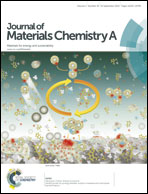From red selenium to cuprous selenide: a novel and facile route to a high performance metal selenide cathode for sensitized solar cells†
Abstract
A novel route using selenium has been developed to fabricate highly catalytic metal selenide counter electrodes (CE) for sensitized solar cells. To demonstrate the facility of this method, copper selenide is fabricated and characterized in this article. Basically, chemically active red selenium has been deposited firmly on FTO through an ultra facile route by disproportionation of Na2SeSO3 aqueous solution with an ethanol spray. Then the red selenium is manipulated as both template and reaction center to fabricate a cuprous embedded CuxSe composite (Cu : Se = 1.66 : 1) CE upon selenium self redox reaction with copper ions. For device performance, CdSeS quantum-dot-sensitized solar cells coupled with the CuxSe composite CE exhibit a much higher photovoltaic performance than their platinum counterparts (3.80% vs. 1.07%) and even better performance (3.80% vs. 3.72%) and photocurrent stability (<5% drop vs. 40% drop) than the optimized cuprous sulfide cathode made from etched brass under consecutive 1 sun illumination. This alternative from selenium could greatly facilitate the counter electrode fabricating process under rigorous conditions and is promising to fabricate other metal selenide functional counter electrodes, such as PbSe, Ag2Se, etc.


 Please wait while we load your content...
Please wait while we load your content...